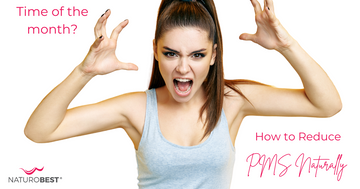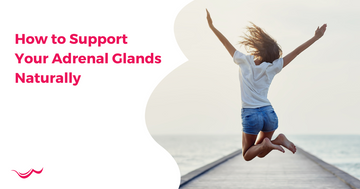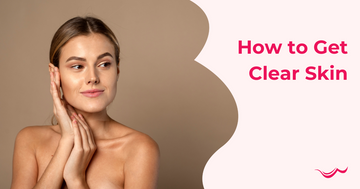
PMS stands for premenstrual syndrome which can occur from ovulation until the first day of your next period. It is very common with over 90% of women experiencing the symptoms of premenstrual syndrome (PMS). Less than 5% of women may suffer from premenstrual dysphoric disorder (PMDD). This is a more severe form of PMS which interferes with daily life at home and at work or school.
PMS Symptoms
Symptoms of PMS include bloating, irritability, sleep disturbances, clumsiness, sore breasts, food cravings and headaches. It is important to keep a diary of your symptoms so that you can rule out other disorders.
For example, if you discovered that you were irritable and/or anxious for most of your cycle, you may be suffering from depression or anxiety. These symptoms may become worse in the one to two weeks prior to your period. But addressing the underlying issue is more important in this case.
If you are over the age of 40 and are feeling more irritable than ever and suffering other symptoms, it’s possible that you may be entering perimenopause. Perimenopause is defined as the years in the lead up to menopause which may last for a decade or more.
PMS Diet & Lifestyle Changes
As much as you might feel like eating a bar of chocolate when those PMS cravings strike, it is only going to make your symptoms worse. Try limiting yourself to two pieces of dark chocolate per day so that you aren’t depriving yourself.
Even better, have some sweet fruit on hand to snack on such as pineapple or berries. A yummy dessert that I love when I have a sweet craving after dinner, is half a banana or some raspberries topped with natural organic yoghurt and either sliced almonds or crushed peanuts – yum! If dairy is an issue for you, try coconut yoghurt.
Try to snack on high protein snacks such as nuts during the day to curb those sweet cravings. Here is an ideal diet for PMS:
Breakfast: Protein shake with rice or almond milk, handful of frozen berries and frozen mango.
Snack: Handful of nuts (I love walnuts and tamari-roasted almonds).
Lunch: Salad topped with haloumi or meat, avocado, pumpkin and sunflower seeds with a balsamic dressing.
Snack: 2 squares of very dark chocolate and a cup of herbal tea.
Dinner: Organic meat or tofu with half a plate of vegetables and brown rice.
Dessert: A cup of warm milk or the dessert I mentioned above.
Natural Treatments for PMS
Treatment of PMS is multi-factorial due to multiple symptoms as a result of complex interactions between organs. This includes the brain, liver and endocrine organs, neurotransmitters and hormones.
Complementary medicine practitioners will treat the body holistically. They aim to minimise symptoms via nutritional, herbal, diet and lifestyle treatments. As well as other treatments specific to their modality (such as acupuncture).
The therapeutic goal is to treat the underlying issues as well as symptoms. This may include regulating hormones, improving liver and bowel function, stabilising mood, relief of fluid retention, headaches and breast pain and improvement of sleep and stress response.
Nutrients for PMS
Zinc
Zinc is the most important mineral when it comes to the reproductive system, hormones and neurotransmitter function. Involved in over 300 enzyme reactions, you can see how your body can fall into a state of dis-ease when you’re deficient.
A common issue with sufferers of PMS is high oestrogen levels. Where there is high oestrogen, there is usually high copper, a mineral that antagonises zinc (and vice versa). High copper levels can cause issues such as anxiety, depression and insomnia.
So it’s hardly surprising that women who suffer from PMS can suffer from these symptoms in the luteal phase of their cycle when oestrogen levels are high. Progesterone, a calming hormone, should also be high at this stage of the cycle, reaching a peak 7 days after ovulation.
Zinc is an essential mineral in the production of the sex hormones oestrogen, progesterone and testosterone. It is also needed for the production of calming neurotransmitters such as serotonin. In my clinic, I found most people to be deficient in zinc and many women had high copper levels.
Although the recommended daily intake of zinc is only 8mg. I found that most women needed a much higher dose than this. Especially if there were trying to conceive.
If you have high copper, the best way of reducing it is to take high doses of zinc. Under the guidance of your health practitioner, with regular blood testing to monitor it.
Vitamin B6
Vitamin B6 has been found to be beneficial for PMS in clinical trials. This is likely due to its positive effect on the neurotransmitter’s serotonin, epinephrine, histamine, dopamine and taurine.
Zinc citrate is a well-absorbed form of zinc. It should be found in high quality multi-vitamins along with vitamin B6 in its active form, pyridoxal-5-phosphate.
Calcium and Magnesium
Calcium and magnesium are two calming minerals that have demonstrated positive effects on PMS in several clinical trials. It is recommended to have 1200 to 1600mg of calcium daily to reduce PMS. Although bear in mind that when taken as a supplement, only 500mg is absorbed in one hit). Natural medicine practitioners often recommend these minerals be taken in a 2:1 ratio, i.e. 500mg of calcium to 250mg magnesium.
Herbal Medicine for PMS
Chaste Tree is probably the most well studied herb for the treatment of PMS and other gynaecologic disorders. Chaste Tree is otherwise known as Vitex agnus-castus. It has been shown to “reduce levels of FSH and increase LH resulting in decreased oestrogen and increased progesterone”.
According to Romm (2014) “one proposed mechanism of action is that this herb causes a decrease in prolactin, which leads to a reversal of LH suppression allowing full development of the corpus luteum, increasing progesterone levels and reducing symptoms of PMS”. This is also the reason why many practitioners prescribe Chaste Tree to support progesterone levels in women who are struggling to conceive. As well as women who have had recurrent miscarriages.
However, a herbalist will create a holistic treatment rather than just focussing on hormones.
Affron® is a patented form of Saffron. A delicious herb when added to food, it has also been clinically trialled for PMS. This herb is also fantastic for mild anxiety and sleeplessness. In fact, I take this herb myself for the symptoms of perimenopause and have found it to be brilliant at reducing irritability and helping me to sleep.
Oestrogen Dominance
Oestrogen dominance is common with PMS. This is either where oestrogen levels are too high or where oestrogen is too high in relation to progesterone. A blood test on day 2 or 3 of your cycle should ideally be between 150-300 pmol/L.
Broccoli is infamous for its ability to process oestrogen via healthy pathways in the body. I recommend eating organic broccoli and other cruciferous vegetables daily, especially in the last half of your cycle.
My other favourite herbs for supporting oestrogen metabolism are Chaste Tree, Grape seed, Pomegranate and Rosemary. In clinical practice, I found that a daily dose of 3gms of Chaste Tree usually helped to lower oestradiol levels within 3 months. Alongside dietary and lifestyle changes.
The Liver Processes Hormones
After cleaning up the diet and getting rid of bad habits. A herbalist will look at how well the liver is functioning as that is the organ that processes hormones. Bupleurum is a liver herb that has a reputation in Chinese medicine to ease anger and irritability. For most women, these are probably the most disturbing symptoms of PMS and the main reason for seeking treatment.
One of the most common physical symptoms is fluid retention and bloating. The best herb I have come across that reduces fluid retention while sustaining potassium levels is dandelion leaf. As a liver herb, dandelion leaf can also act as a mild laxative which is helpful for women who suffer from constipation in the premenstrual period.
Acne breakouts prior to your period are common and one of my favourite herbs for this is Burdock. Known as a blood cleanser, this beautiful herb will help to keep your bowels regular while keeping your skin clear.
When it comes to processing hormones, Schisandra is my favourite liver herb as it enhances both phase I and II detoxification of the liver. It is traditionally prescribed in Western herbal medicine for liver support as well as improving physical and mental performance and concentration.
You will find all of the above herbs in our new Detox & Liver Support.
Conclusion
When it comes to PMS, it’s not as easy as taking one remedy as a cure-all. Women require a holistic treatment plan, treating the underlying conditions and the specific symptoms that she presents with. Talking to your natural medicine practitioner is a great place to start.
In the meantime you may want to try the following combination as a PMS/Perimenopause Power Pack:
PMS Support & Antioxidant - take one capsule in the morning before breakfast. If you have high oestradiol levels on day 2 or 3 of your cycle, take two capsules.
Detox & Liver Support taken at night after dinner alongside Calcium & Magnesium Plus K2 & D3.
Stress & Sleep PM Formula taken one hour before bed.




